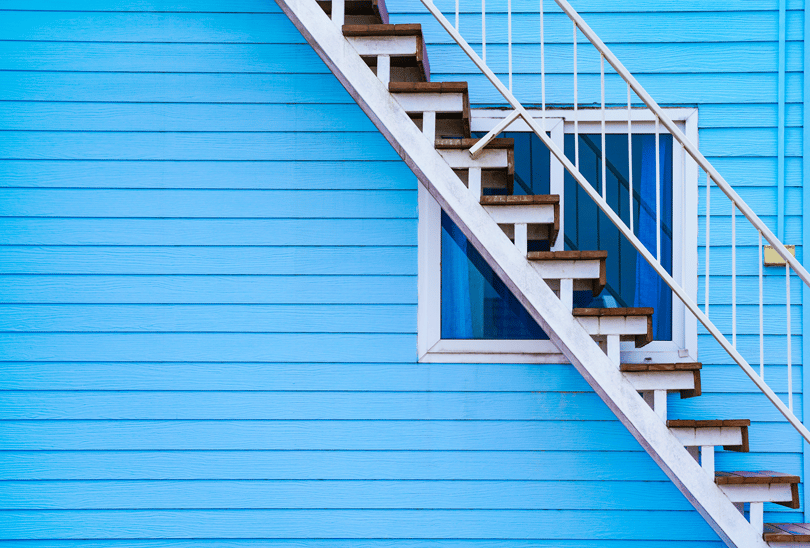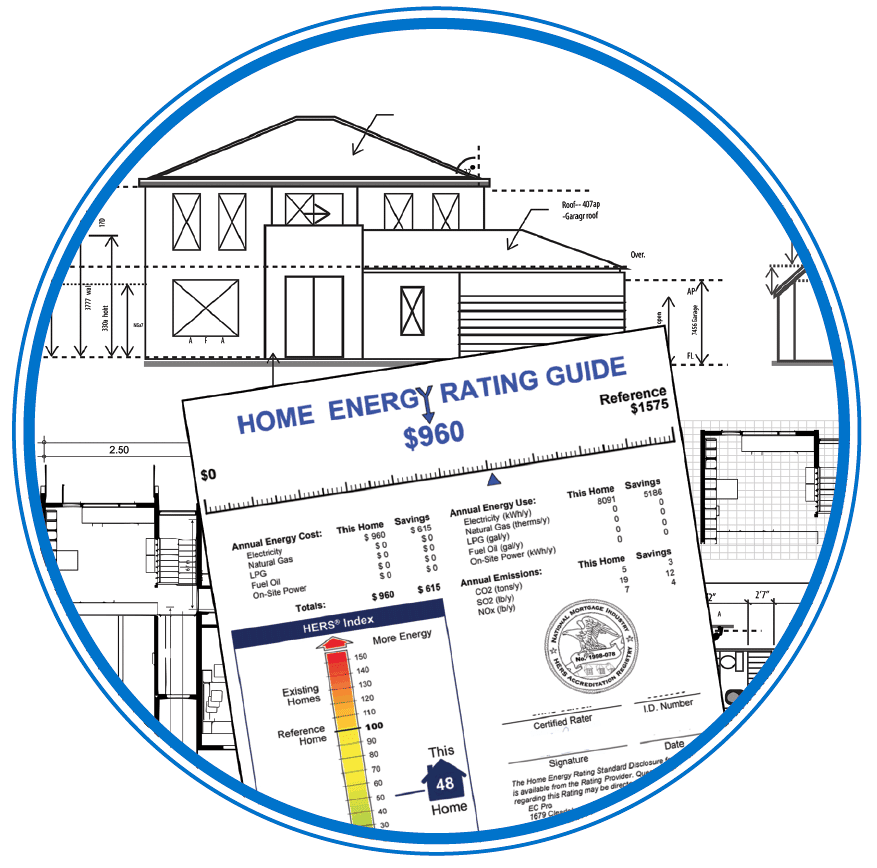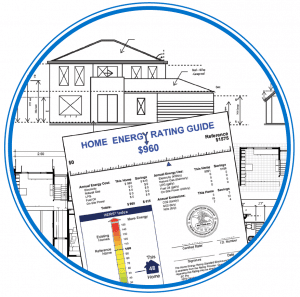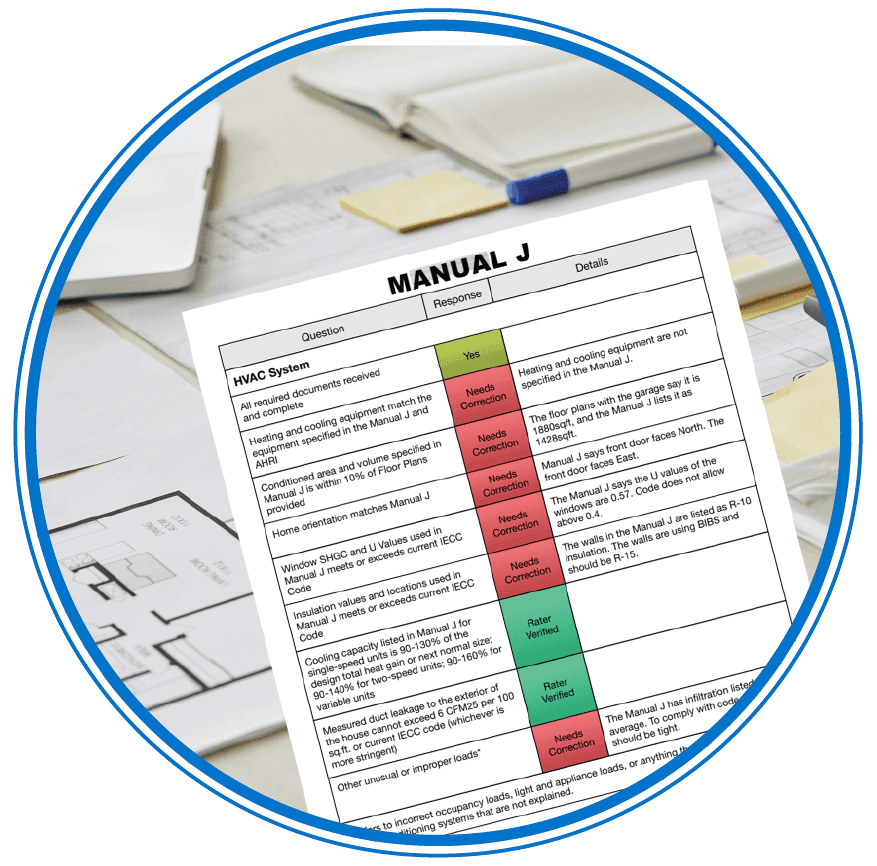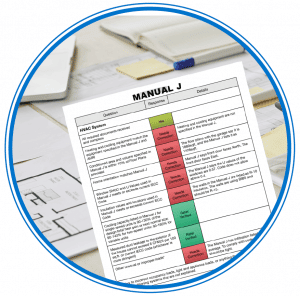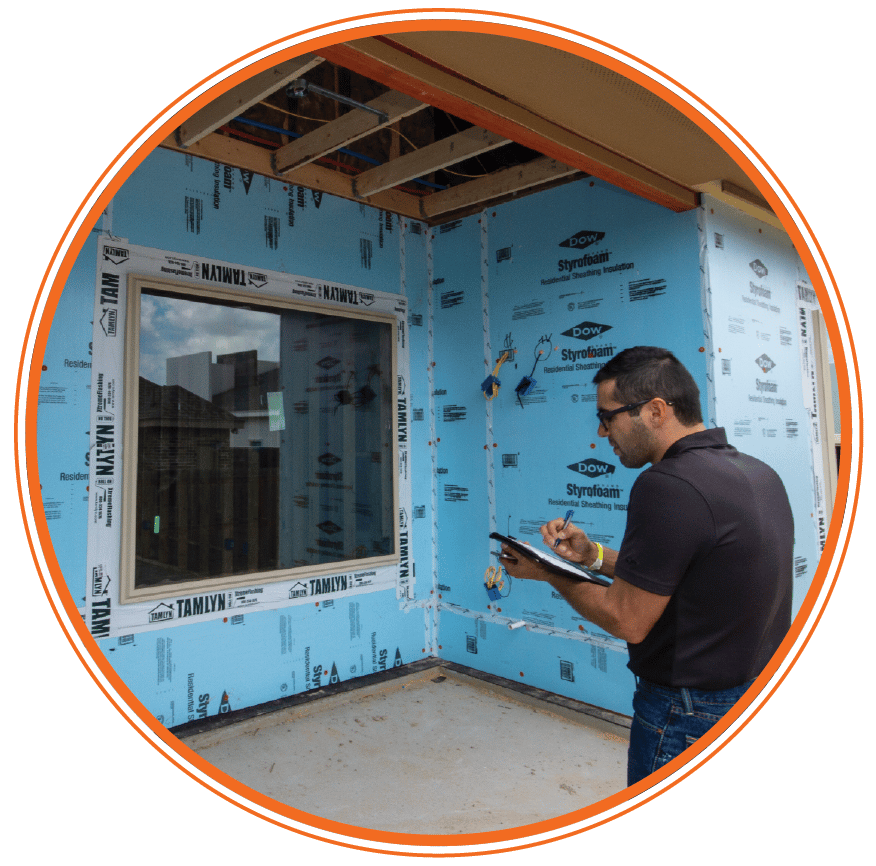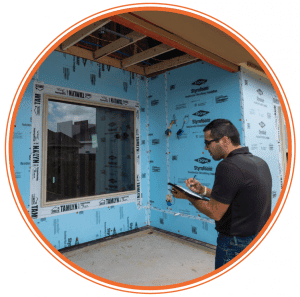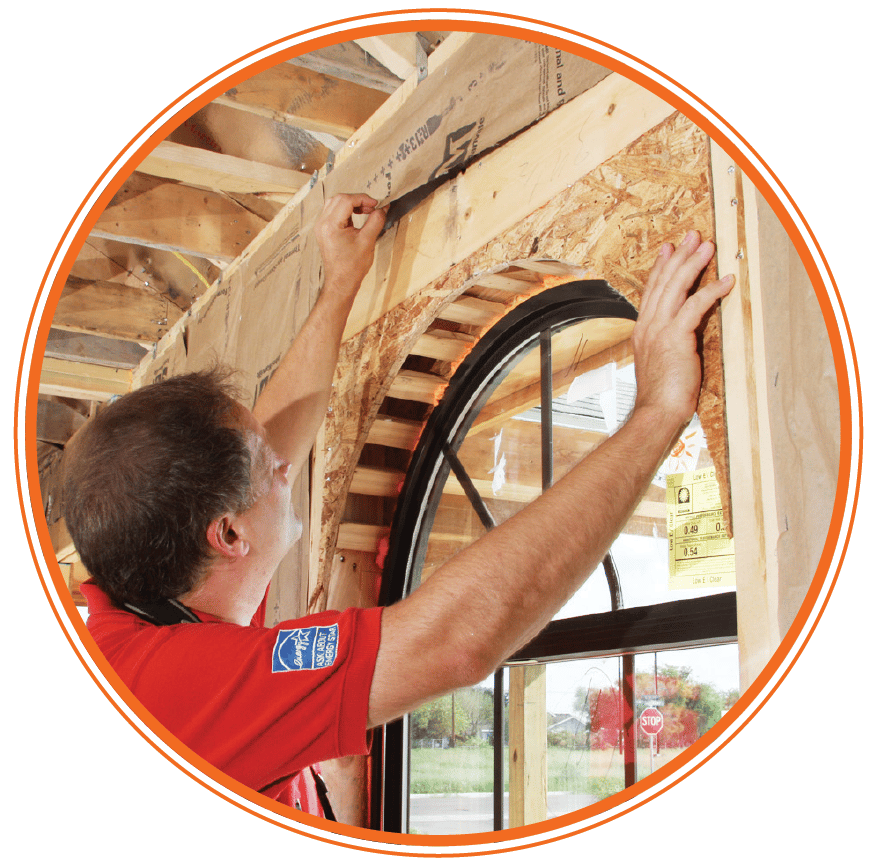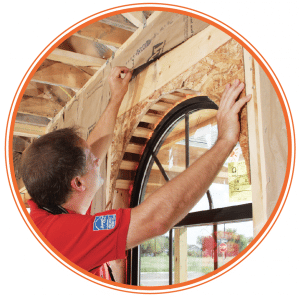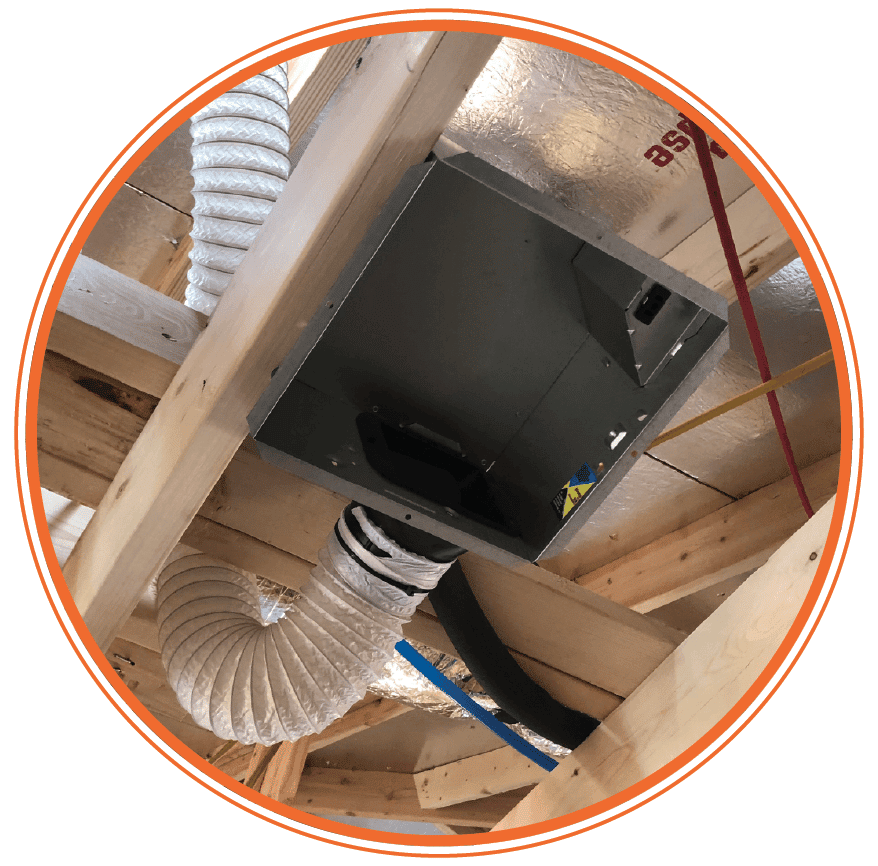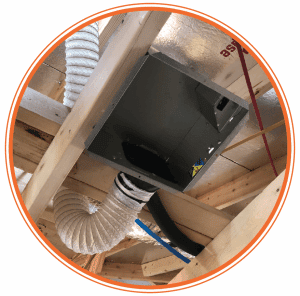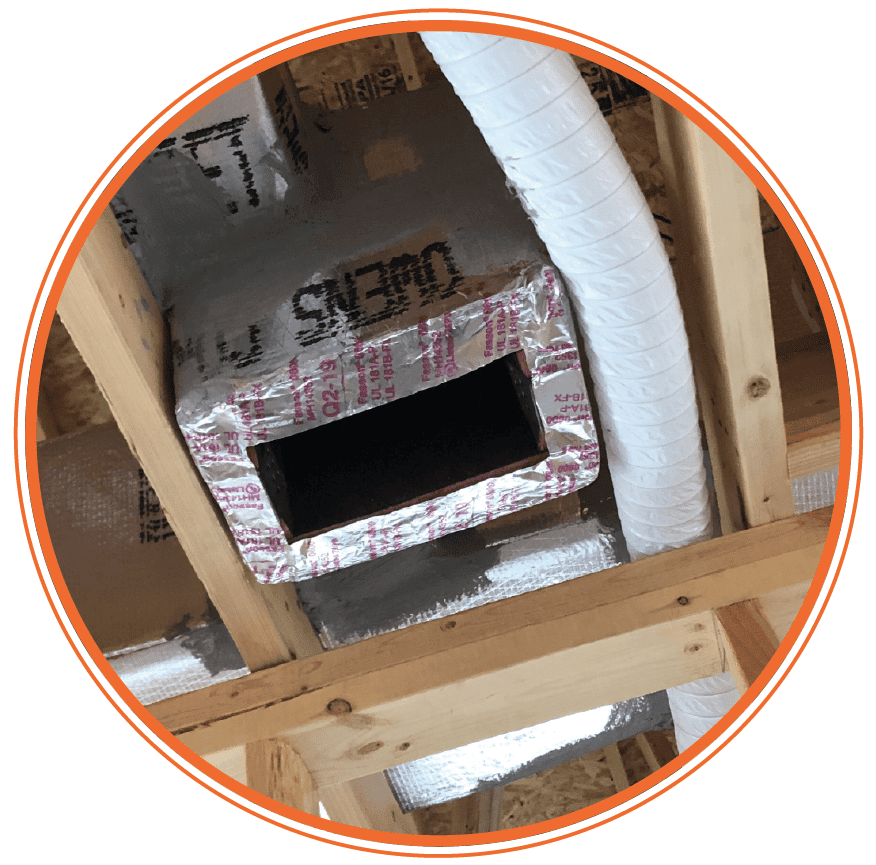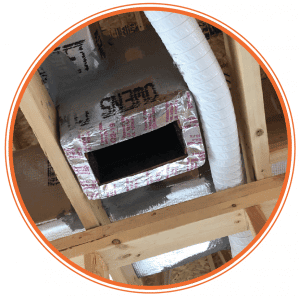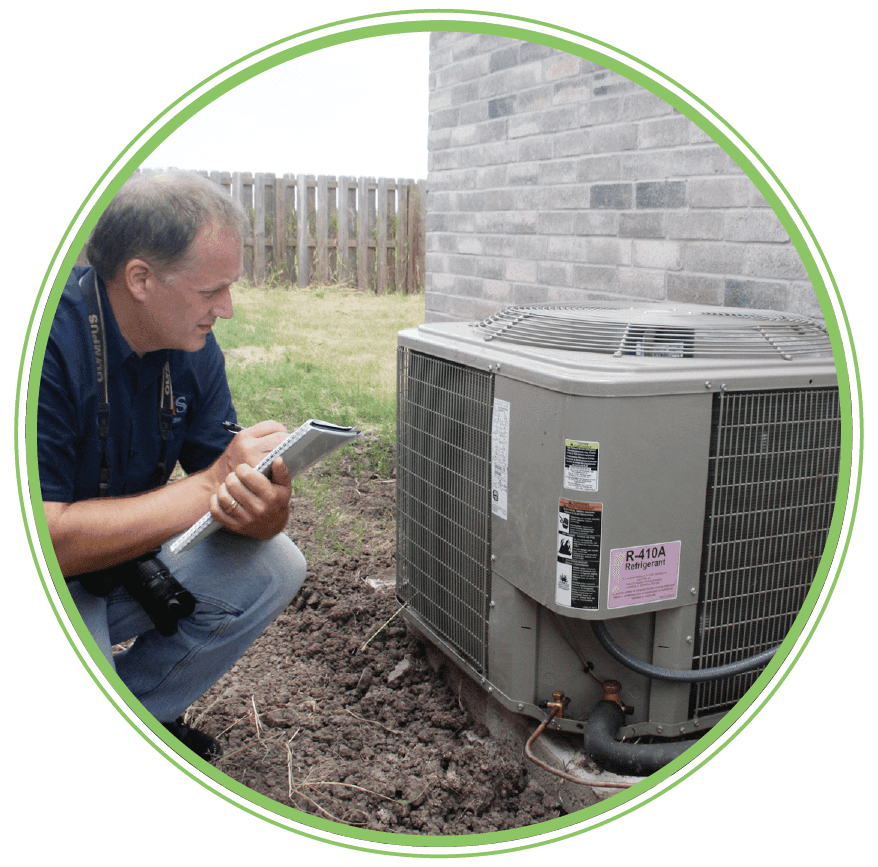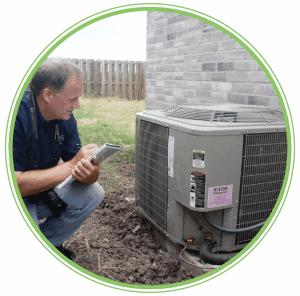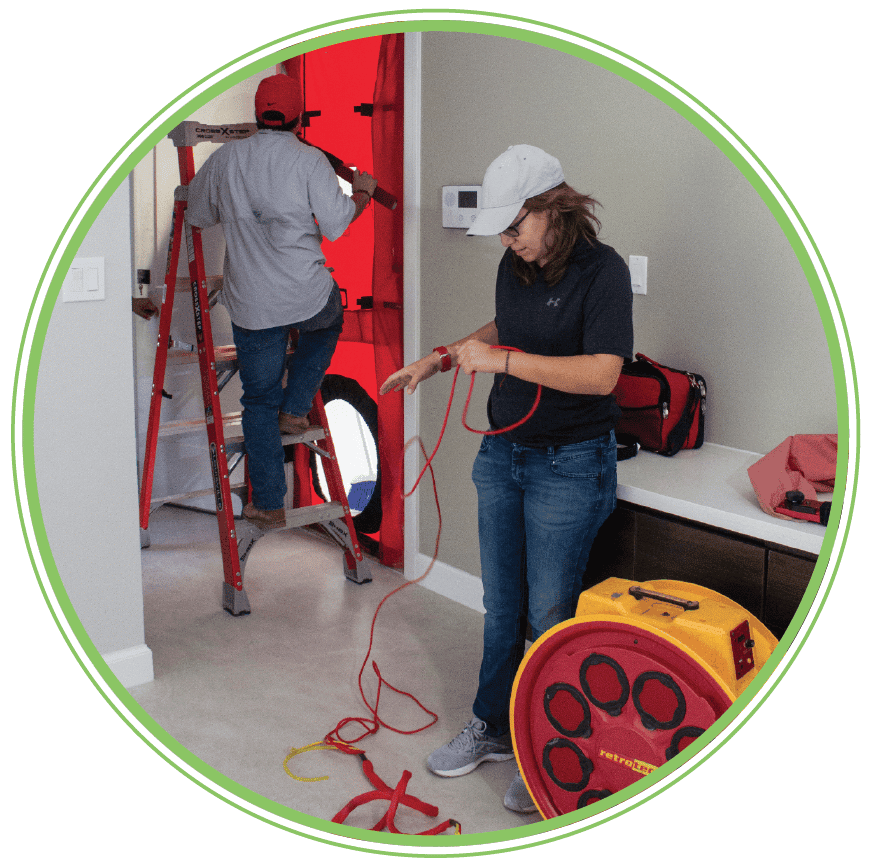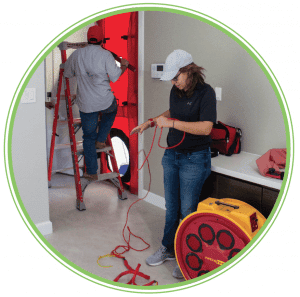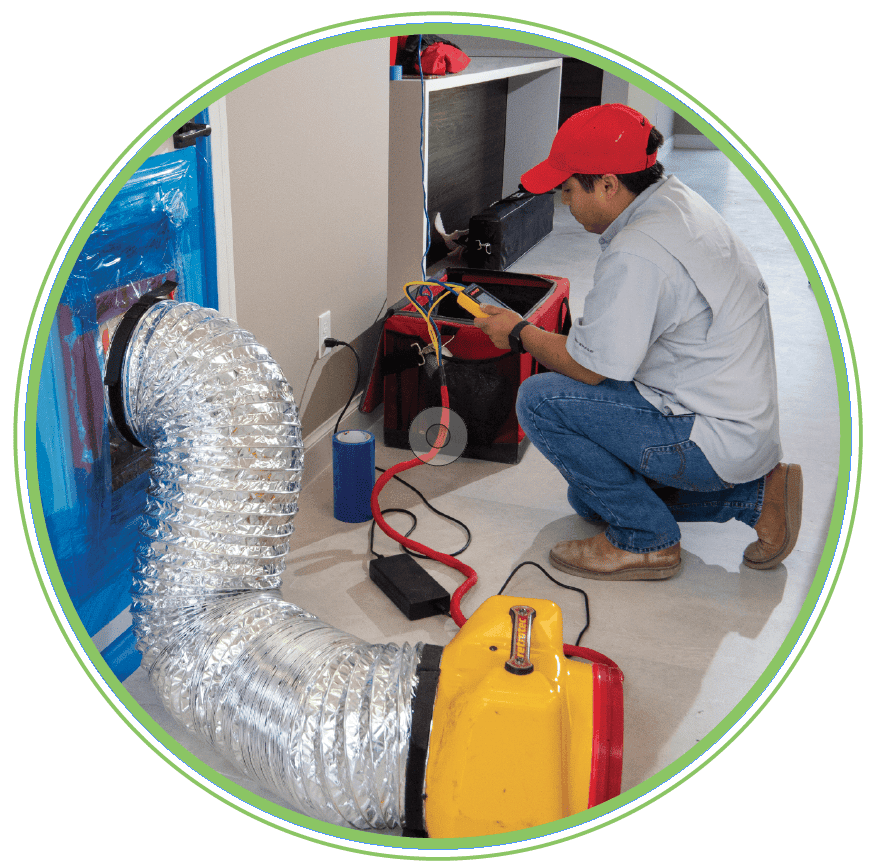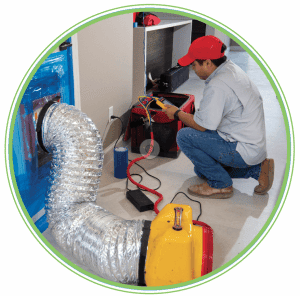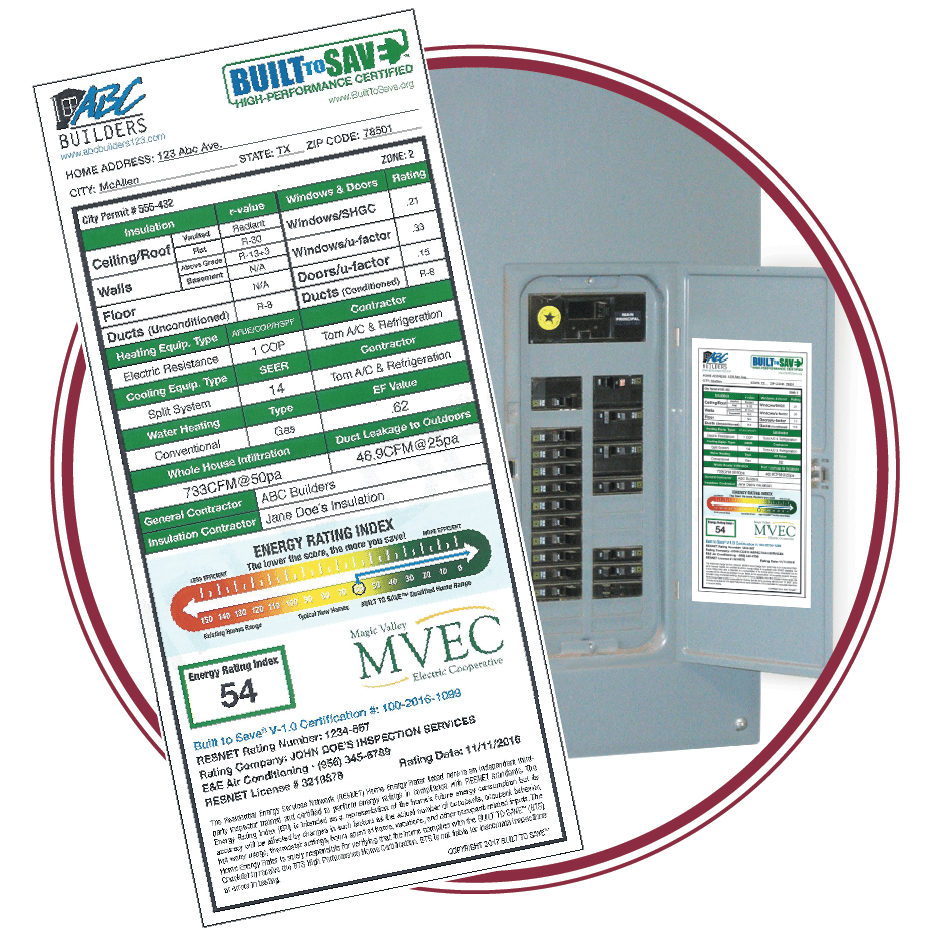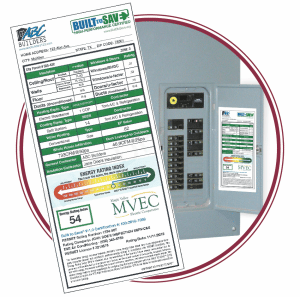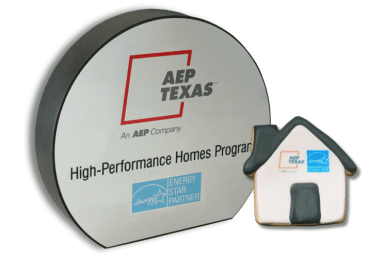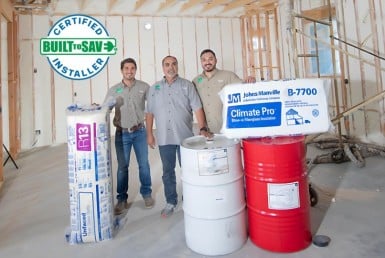4 Steps To A BUILT TO SAVE™ Certification
The benefits of the BUILT TO SAVE™ program for homebuyers that include savings on utilities, better indoor air, and enhanced home comfort are rooted in the whole-house systematic approach to good building science. Ideally, the approach should begin before the home is built to predict the home’s energy efficiency. Here’s a step-by-step approach to how a high-performance home is born.
1. PRE-CONSTRUCTION
PROJECTED ENERGY EFFICIENCY ANALYSIS
The first step in the BUILT TO SAVE™ process is the uploading of the home’s plans, including: elevation and floorplan blueprints; Manual J; energy-saving items in the home like ENERGY STAR™ appliances; and heating and cooling equipment information. The data from these documents is entered into a licensed home energy Rater’s specialized software that produces a projected Energy Rating Index (ERI) score. The ERI is a good predictor of a home’s energy performance once it is built.
NOTE: A projected analysis done before the home is built makes it easy and much less costly to make adjustments to achieve the targeted ERI instead of waiting to do this once construction is underway.
PROJECTED ENERGY EFFICIENCY ANALYSIS
The first step in the BUILT TO SAVE™ process is the uploading of the home’s plans, including: elevation and floorplan blueprints; Manual J; energy-saving items in the home like ENERGY STAR™ appliances; and heating and cooling equipment information. The data from these documents is entered into a licensed home energy Rater’s specialized software that produces a projected Energy Rating Index (ERI) score. The ERI is a good predictor of a home’s energy performance once it is built.
NOTE: A projected analysis done before the home is built makes it easy and much less costly to make adjustments to achieve the targeted ERI instead of waiting to do this once construction is underway.
THE MANUAL J
Heating, Ventilation, and Air Conditioning (HVAC) contractors prepare a Manual J by entering the home’s blueprint information into a program that calculates the heating and cooling loads of a home and recommends the proper size unit required for the home’s specifications. The software is adapted to the particular climate that the home is located in. The Manual J also calculates the amount of heat and humidity that each occupant of the home will add to the interior of the home.
NOTE: A properly sized heating and cooling system is critical to energy savings and, more importantly, to a home’s comfort. A system that is oversized will waste more energy, have more maintenance issues, reduce comfort by cycling on and off before it has a chance to remove the humidity in the home, and cause moisture and mold issues over time.
THE MANUAL J
Heating, Ventilation, and Air Conditioning (HVAC) contractors prepare a Manual J by entering the home’s blueprint information into a program that calculates the heating and cooling loads of a home and recommends the proper size unit required for the home’s specifications. The software is adapted to the particular climate that the home is located in. The Manual J also calculates the amount of heat and humidity that each occupant of the home will add to the interior of the home.
NOTE: A properly sized heating and cooling system is critical to energy savings and, more importantly, to a home’s comfort. A system that is oversized will waste more energy, have more maintenance issues, reduce comfort by cycling on and off before it has a chance to remove the humidity in the home, and cause moisture and mold issues over time.
2. INITIAL INSPECTION
THERMAL INSPECTION
The thermal inspection is performed after insulation is installed and before the walls are put in place. A home energy Rater visually inspects all areas of the home to check that the insulation used is of the proper R-values and, more importantly, that it was installed correctly. Insulation that has been compressed by force between the studs or into crevices lose their R-value and will not perform as insulation. Even spray form insulation can be poorly installed with voids inside that are formed by bubbles during application. Special attention is given to areas that will allow cold air to escape to the attic or to the outside.
NOTE: According to the Department of Energy, a typical home has about a half-mile of cracks and gaps throughout. This results in a 20% to 40% increase in heating and cooling costs every year through air leakage. A thermal inspection performed by a third-party Rater will give the peace of mind that your home was sealed properly.
THERMAL INSPECTION
The thermal inspection is performed after insulation is installed and before the walls are put in place. A home energy Rater visually inspects all areas of the home to check that the insulation used is of the proper R-values and, more importantly, that it was installed correctly. Insulation that has been compressed by force between the studs or into crevices lose their R-value and will not perform as insulation. Even spray form insulation can be poorly installed with voids inside that are formed by bubbles during application. Special attention is given to areas that will allow cold air to escape to the attic or to the outside.
NOTE: According to the Department of Energy, a typical home has about a half-mile of cracks and gaps throughout. This results in a 20% to 40% increase in heating and cooling costs every year through air leakage. A thermal inspection performed by a third-party Rater will give the peace of mind that your home was sealed properly.
MOISTURE CONTROL
The Rater will look for areas that could potentially create moisture problems in the future by inspecting the home’s envelope, which includes the outer walls, ceiling, and windows. Since the window manufacturer’s labels are in place at this point, the Rater makes notes to ensure that their values are as required by code and that they relate to what was specified in the Manual J. Areas behind bathtubs located near an exterior wall are noted to make sure that a waterproof backing will be used to avoid moisture issues caused by changes in temperature.
NOTE: Although moisture management is not a factor in energy efficiency, ensuring against moisture problems is included in BUILT TO SAVE™ inspections as part of its “whole-house” approach to providing a healthy home environment.
MOISTURE CONTROL
The Rater will look for areas that could potentially create moisture problems in the future by inspecting the home’s envelope, which includes the outer walls, ceiling, and windows. Since the window manufacturer’s labels are in place at this point, the Rater makes notes to ensure that their values are as required by code and that they relate to what was specified in the Manual J. Areas behind bathtubs located near an exterior wall are noted to make sure that a waterproof backing will be used to avoid moisture issues caused by changes in temperature.
NOTE: Although moisture management is not a factor in energy efficiency, ensuring against moisture problems is included in BUILT TO SAVE™ inspections as part of its “whole-house” approach to providing a healthy home environment.
VENTILATION
Tight construction is required for superior energy efficiency, and as the home becomes tighter, it is very important that a proper fresh air system is installed to allow the home to breathe. A visual inspection looks for properly placed ventilation systems, which is especially important if the insulation being used is spray foam due to its maximum sealing characteristics. A variety of humidity controlling devices are available on the market today that can greatly enhance the comfort levels of a home.
NOTE: Proper mechanical ventilation is key to ensuring the quality of indoor air. Ventilation is nothing more than replacing stale air with fresh air and is critical for tightly constructed homes that can trap dust, pollen, and unhealthy air that results from day-to-day activities like cooking, bathing, and even the occupants’ breathing.
VENTILATION
Tight construction is required for superior energy efficiency, and as the home becomes tighter, it is very important that a proper fresh air system is installed to allow the home to breathe. A visual inspection looks for properly placed ventilation systems, which is especially important if the insulation being used is spray foam due to its maximum sealing characteristics. A variety of humidity controlling devices are available on the market today that can greatly enhance the comfort levels of a home.
NOTE: Proper mechanical ventilation is key to ensuring the quality of indoor air. Ventilation is nothing more than replacing stale air with fresh air and is critical for tightly constructed homes that can trap dust, pollen, and unhealthy air that results from day-to-day activities like cooking, bathing, and even the occupants’ breathing.
DUCTS & AIR REGISTERS
The Rater inspects the HVAC duct system, looking for areas that are poorly sealed and connected. Mastic is an inexpensive sealant that should be used generously over taping at all the seams for maximum protection. Simply using foil tape is not acceptable since heat will cause the tape to fall off and allow air to escape into the attic. The ducts, where they connect to vents and registers in the ceiling, are inspected to make sure they will connect properly.
NOTE: A properly designed duct system, a function of the HVAC contractor, is key to making sure every room of the home gets equal air with equal pressure. Failure to equalize air flow will mean some rooms will be colder or hotter than others.
DUCTS & AIR REGISTERS
The Rater inspects the HVAC duct system, looking for areas that are poorly sealed and connected. Mastic is an inexpensive sealant that should be used generously over taping at all the seams for maximum protection. Simply using foil tape is not acceptable since heat will cause the tape to fall off and allow air to escape into the attic. The ducts, where they connect to vents and registers in the ceiling, are inspected to make sure they will connect properly.
NOTE: A properly designed duct system, a function of the HVAC contractor, is key to making sure every room of the home gets equal air with equal pressure. Failure to equalize air flow will mean some rooms will be colder or hotter than others.
3. FINAL INSPECTION
VERIFICATION OF FINAL RESULTS
A final review of the home’s specifications is made to verify that the home was built as was specified during the pre-construction stage, making note of items that can add or detract from the home’s projected ERI score. Additionally, the Final Inspection includes a Blower Door Test and a Duct Leakage Test to calculate the home’s ERI score.
VERIFICATION OF FINAL RESULTS
A final review of the home’s specifications is made to verify that the home was built as was specified during the pre-construction stage, making note of items that can add or detract from the home’s projected ERI score. Additionally, the Final Inspection includes a Blower Door Test and a Duct Leakage Test to calculate the home’s ERI score.
THE BLOWER DOOR TEST
A Blower Door Test is performed once the home is completed to measure the leakiness of the home’s envelope—how much air goes out or comes in through the roof, windows, doors, and other openings. To do this, a Rater closes all the doors and windows and other openings, such as vents to the outside, and uses a specialized fan on a doorway of the home to blow air in and then out. The home’s leakage to the outside must fall within the acceptable range to qualify for the BUILT TO SAVE™ certification.
NOTE: The Blower Door Test is usually performed after the home is complete, but a Rough-in Blower Door Test can be performed at the Thermal Inspection stage if all of the home’s openings can be covered, even if plywood and tape are used to cover them. The advantage of doing the test at this stage is that problem areas can be easily identified and fixed. And if the home passes the test at this stage, you will be assured it will pass at Final Inspection.
THE BLOWER DOOR TEST
A Blower Door Test is performed once the home is completed to measure the leakiness of the home’s envelope—how much air goes out or comes in through the roof, windows, doors, and other openings. To do this, a Rater closes all the doors and windows and other openings, such as vents to the outside, and uses a specialized fan on a doorway of the home to blow air in and then out. The home’s leakage to the outside must fall within the acceptable range to qualify for the BUILT TO SAVE™ certification.
NOTE: The Blower Door Test is usually performed after the home is complete, but a Rough-in Blower Door Test can be performed at the Thermal Inspection stage if all of the home’s openings can be covered, even if plywood and tape are used to cover them. The advantage of doing the test at this stage is that problem areas can be easily identified and fixed. And if the home passes the test at this stage, you will be assured it will pass at Final Inspection.
THE DUCT LEAKAGE TEST
The Duct Leakage test identifies leaks in the joints and seams of the ductwork in the HVAC system using diagnostic hardware to measure the airtightness of the ducts. The procedure uses a calibrated fan that measures the air flow rate and a pressure sensing device that measures the pressure created by the fan’s air. The amount of leakage must fall within an acceptable range to meet the requirements of the BUILT TO SAVE™ program.
NOTE: An acceptable Duct Leakage test in Climate Zone 2 requires air leakage rates of less than four percent of conditioned floor area (living space). Anything more means too much air is escaping from the ducts and costing you money.
THE DUCT LEAKAGE TEST
The Duct Leakage test identifies leaks in the joints and seams of the ductwork in the HVAC system using diagnostic hardware to measure the airtightness of the ducts. The procedure uses a calibrated fan that measures the air flow rate and a pressure sensing device that measures the pressure created by the fan’s air. The amount of leakage must fall within an acceptable range to meet the requirements of the BUILT TO SAVE™ program.
NOTE: An acceptable Duct Leakage test in Climate Zone 2 requires air leakage rates of less than four percent of conditioned floor area (living space). Anything more means too much air is escaping from the ducts and costing you money.
4. PROOF OF HIGH-PERFORMANCE
THE BUILT TO SAVE™ CERTIFICATE
The BUILT TO SAVE™ certificate is critical proof that the home qualified as a high-performance home. The supporting documentation provided by the Rater is kept on file by BUILT TO SAVE™ as proof of the home’s compliance and includes all of the documents submitted by the builder, photos taken during inspections, any issues that were found and corrected, and photos of the readings on the manometers used during final testing.
NOTE: Aside from the peace of mind the BUILT TO SAVE™ certificate will give you, it will be invaluable if you decide to sell your home. It trumps telling your prospective buyer that you were told the home is a high-performance home.
THE BUILT TO SAVE™ CERTIFICATE
The BUILT TO SAVE™ certificate is critical proof that the home qualified as a high-performance home. The supporting documentation provided by the Rater is kept on file by BUILT TO SAVE™ as proof of the home’s compliance and includes all of the documents submitted by the builder, photos taken during inspections, any issues that were found and corrected, and photos of the readings on the manometers used during final testing.
NOTE: Aside from the peace of mind the BUILT TO SAVE™ certificate will give you, it will be invaluable if you decide to sell your home. It trumps telling your prospective buyer that you were told the home is a high-performance home.
THE BUILT TO SAVE™ LABEL
Building codes require that every home has a label that lists information on critical components of the home, such as insulation, windows and doors, and heating and cooling equipment that all show types and ratings.
NOTE: While this label is required by law, unfortunately few homes have it. This mandatory label is included with the BUILT TO SAVE™ certificate.
THE BUILT TO SAVE™ LABEL
Building codes require that every home has a label that lists information on critical components of the home, such as insulation, windows and doors, and heating and cooling equipment that all show types and ratings.
NOTE: While this label is required by law, unfortunately few homes have it. This mandatory label is included with the BUILT TO SAVE™ certificate.
© RGV New Homes Guide, 2021. Unauthorized use and/or duplication of this material without express and written permission from this site’s author and/or owner is strictly prohibited. Excerpts and links may be used, provided that full and clear credit is given to RGV New Homes Guide with appropriate and specific direction to the original content.

